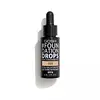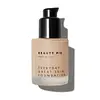What's inside
What's inside
 Key Ingredients
Key Ingredients

 Benefits
Benefits

No benefits
 Concerns
Concerns

 Ingredients Side-by-side
Ingredients Side-by-side

Water
Skin ConditioningCyclopentasiloxane
EmollientDimethicone
EmollientIsododecane
EmollientTalc
AbrasivePEG-10 Dimethicone
Skin ConditioningEthylene/Acrylic Acid Copolymer
Emulsion StabilisingOctocrylene
UV AbsorberAlcohol Denat.
AntimicrobialPEG-4
HumectantIsononyl Isononanoate
EmollientCaprylyl Dimethicone Ethoxy Glucoside
EmulsifyingPolyethylmethacrylate
Myristyl Myristate
EmollientPolysorbate 20
EmulsifyingDisteardimonium Hectorite
StabilisingCetyl Dimethicone
EmollientDimethicone/Vinyl Dimethicone Crosspolymer
Skin ConditioningBenzyl Alcohol
PerfumingSodium Dehydroacetate
PreservativeTmp Dimethicone
EmollientMagnesium Aluminum Silicate
AbsorbentTocopheryl Acetate
AntioxidantTriethoxycaprylylsilane
Aluminum Hydroxide
EmollientPolymethylsilsesquioxane
Disodium EDTA
Biosaccharide Gum-4
Skin ConditioningSodium Hyaluronate
HumectantPhenoxyethanol
PreservativeParfum
MaskingTitanium/Titanium Dioxide
Cosmetic ColorantCI 77492
Cosmetic ColorantCI 77491
Cosmetic ColorantCI 77499
Cosmetic ColorantT-Butyl Alcohol
PerfumingAlcohol
AntimicrobialWater, Cyclopentasiloxane, Dimethicone, Isododecane, Talc, PEG-10 Dimethicone, Ethylene/Acrylic Acid Copolymer, Octocrylene, Alcohol Denat., PEG-4, Isononyl Isononanoate, Caprylyl Dimethicone Ethoxy Glucoside, Polyethylmethacrylate, Myristyl Myristate, Polysorbate 20, Disteardimonium Hectorite, Cetyl Dimethicone, Dimethicone/Vinyl Dimethicone Crosspolymer, Benzyl Alcohol, Sodium Dehydroacetate, Tmp Dimethicone, Magnesium Aluminum Silicate, Tocopheryl Acetate, Triethoxycaprylylsilane, Aluminum Hydroxide, Polymethylsilsesquioxane, Disodium EDTA, Biosaccharide Gum-4, Sodium Hyaluronate, Phenoxyethanol, Parfum, Titanium/Titanium Dioxide, CI 77492, CI 77491, CI 77499, T-Butyl Alcohol, Alcohol
Water
Skin ConditioningCyclopentasiloxane
EmollientDimethicone
EmollientAlcohol
AntimicrobialEthylene/Acrylic Acid Copolymer
Emulsion StabilisingPEG-4
HumectantHdi/Trimethylol Hexyllactone Crosspolymer
Polysorbate 20
EmulsifyingPEG-10 Dimethicone
Skin ConditioningIsononyl Isononanoate
EmollientDisteardimonium Hectorite
StabilisingTrimethylsiloxysilicate
EmollientCaprylyl Dimethicone Ethoxy Glucoside
EmulsifyingDimethicone/Vinyl Dimethicone Crosspolymer
Skin ConditioningMyristyl Lactate
EmollientPhenoxyethanol
PreservativeSodium Chloride
MaskingBenzyl Alcohol
PerfumingSynthetic Fluorphlogopite
Sodium Dehydroacetate
PreservativeAluminum Hydroxide
EmollientTocopheryl Acetate
AntioxidantCetyl Dimethicone
EmollientSilica
AbrasiveStearoyl Inulin
EmollientDisodium EDTA
Sodium Lauroyl Glutamate
Lysine
Skin ConditioningTriethoxycaprylylsilane
Titanium Dioxide
Cosmetic ColorantCI 77491
Cosmetic ColorantCI 77492
Cosmetic ColorantCI 77499
Cosmetic ColorantWater, Cyclopentasiloxane, Dimethicone, Alcohol, Ethylene/Acrylic Acid Copolymer, PEG-4, Hdi/Trimethylol Hexyllactone Crosspolymer, Polysorbate 20, PEG-10 Dimethicone, Isononyl Isononanoate, Disteardimonium Hectorite, Trimethylsiloxysilicate, Caprylyl Dimethicone Ethoxy Glucoside, Dimethicone/Vinyl Dimethicone Crosspolymer, Myristyl Lactate, Phenoxyethanol, Sodium Chloride, Benzyl Alcohol, Synthetic Fluorphlogopite, Sodium Dehydroacetate, Aluminum Hydroxide, Tocopheryl Acetate, Cetyl Dimethicone, Silica, Stearoyl Inulin, Disodium EDTA, Sodium Lauroyl Glutamate, Lysine, Triethoxycaprylylsilane, Titanium Dioxide, CI 77491, CI 77492, CI 77499
Ingredients Explained
These ingredients are found in both products.
Ingredients higher up in an ingredient list are typically present in a larger amount.
Alcohol comes in many different forms. Different types of alcohol will have different effects on skin. This ingredient is usually an astringent alcohol.
These alcohols are drying on the skin. They may strip away your skin's natural oils and even damage your skin barrier. Astringent alcohols may also irritate skin.
Other types of astringent alcohols include:
According to the National Rosacea Society based in the US, you should be mindful of products with these alcohols in the top half of ingredients.
Any type of sanitizing product will have high amounts of alcohol to help kill bacteria and viruses.
Fatty alcohols come from plant oils such as coconut oil. These can help hydrate the skin and are non-irritating. Some fatty alcohols include cetyl and stearyl alcohol.
Learn more about AlcoholAluminum Hydroxide is a form of aluminum. It can be naturally found in nature as the mineral gibbsite. In cosmetics, Aluminum Hydroxide is used as a colorant, pH adjuster, and absorbent.
As a colorant, Aluminum Hydroxide may add opacity, or reduce the transparency. Aluminum hydroxide is contains both basic and acidic properties.
According to manufacturers, this ingredient is an emollient and humectant. This means it helps hydrate the skin.
In medicine, this ingredient is used to help relieve heartburn and help heal ulcers.
There is currently no credible scientific evidence linking aluminum hydroxide in cosmetics to increased cancer risk.
Major health organizations allow the use of aluminum hydroxide in personal care products and have not flagged it as a carcinogenic risk at typical usage levels.
Learn more about Aluminum HydroxideBenzyl Alcohol is most commonly used as a preservative. It also has a subtle, sweet smell. Small amounts of Benzyl Alcohol is not irritating and safe to use in skincare products. Most Benzyl Alcohol is derived from fruits such as apricots.
Benzyl Alcohol has both antibacterial and antioxidant properties. These properties help lengthen the shelf life of products. Benzyl Alcohol is a solvent and helps dissolve other ingredients. It can also improve the texture and spreadability.
Alcohol comes in many different forms. Different types of alcohol will have different effects on skin. This ingredient is an astringent alcohol.
Using high concentrations of these alcohols are drying on the skin. They may strip away your skin's natural oils and even damage your skin barrier. Astringent alcohols may also irritate skin.
Other types of astringent alcohols include:
According to the National Rosacea Society based in the US, you should be mindful of products with these alcohols in the top half of ingredients.
Any type of sanitizing product will have high amounts of alcohol to help kill bacteria and viruses.
Learn more about Benzyl AlcoholCaprylyl Dimethicone Ethoxy Glucoside is a type of silicone.
Cetyl Dimethicone is a type of silicone.
Ci 77491 is also hydrated iron III oxide. It's sole purpose is to give a red/pink hue to products.
Iron III oxides are classified as inorganic chemicals for coloring.
Synthetically created Ci 77491 is considered safer than those naturally found. This is because the synthetically created version may contain less impurities. Iron oxides are generally non-toxic and non-allergenic.
Learn more about CI 77491Ci 77492 is also hydrated iron III oxide. It's sole purpose is to give a yellow hue to products.
Iron III oxides are classified as inorganic chemicals for coloring.
Synthetically created Ci 77492 is considered safer than those naturally found. This is because the synthetically created version may contain less impurities. Iron oxides are generally non-toxic and non-allergenic.
Learn more about CI 77492Ci 77499 is also hydrated iron III oxide. It is created from mixing red and black iron oxides. This helps give shades of darkness to a product.
Iron III oxides are classified as inorganic chemicals for coloring.
Cyclopentasiloxane, or D5, is a silicone used to improve texture of products and trap moisture.
D5 is considered lightweight and volatile. Volatile means it evaporates quickly after application. Once evaporated, D5 leaves a thin barrier that helps keep skin hydrated.
It is also an emollient. Emollients help soften the skin and prevent water loss. Silicones create a silky texture in products. D5 helps other ingredients become more spreadable.
Studies show D5 is safe to use in skincare products. We recommend speaking with a skincare professional if you have concerns.
Learn more about CyclopentasiloxaneDimethicone is a type of synthetic silicone created from natural materials such as quartz.
What it does:
Dimethicone comes in different viscosities:
Depending on the viscosity, dimethicone has different properties.
Ingredients lists don't always show which type is used, so we recommend reaching out to the brand if you have questions about the viscosity.
This ingredient is unlikely to cause irritation because it does not get absorbed into skin. However, people with silicone allergies should be careful about using this ingredient.
Note: Dimethicone may contribute to pilling. This is because it is not oil or water soluble, so pilling may occur when layered with products. When mixed with heavy oils in a formula, the outcome is also quite greasy.
Learn more about DimethiconeThis ingredient is a silicone used to improve the texture of products and absorb oil. It does not get absorbed into the skin.
Like other silicones, Dimethicone/Vinyl Dimethicone Crosspolymer helps condition the skin by creating a barrier. In this sense, it can act as an emollient and trap moisture in.
This ingredient is a type of elastomer.
Learn more about Dimethicone/Vinyl Dimethicone CrosspolymerDisodium EDTA plays a role in making products more stable by aiding other preservatives.
It is a chelating agent, meaning it neutralizes metal ions that may be found in a product.
Disodium EDTA is a salt of edetic acid and is found to be safe in cosmetic ingredients.
Learn more about Disodium EDTADisteardimonium Hectorite comes from the clay mineral named hectorite. It is used to add thickness to a product.
It can also help stabilize a product by helping to disperse other ingredients.
Hectorite is a rare, white clay mineral.
Learn more about Disteardimonium HectoriteWe don't have a description for Ethylene/Acrylic Acid Copolymer yet.
Isononyl Isononanoate is a synthetic skin-conditioner and texture enhancer. It is created from nonanoic acid, a fatty acid found in cocoa and lavender oil.
As an emollient, Isononyl Isononanoate helps keep your skin soft and smooth. This is because emollients create a barrier on the skin to trap moisture in.
Isononyl Isononanoate helps give products a velvet feel and improves spreadability.
Learn more about Isononyl IsononanoatePeg-10 Dimethicone is silicone with conditioner and emulsifier properties. It mostly acts as an emollient in skincare and and humectant in haircare.
According to the manufacturer, acidic formulations decrease the stability of this ingredient. It works best in neutral or near neutral formulations.
We don't have a description for PEG-4 yet.
Phenoxyethanol is a preservative that has germicide, antimicrobial, and aromatic properties. Studies show that phenoxyethanol can prevent microbial growth. By itself, it has a scent that is similar to that of a rose.
It's often used in formulations along with Caprylyl Glycol to preserve the shelf life of products.
Polysorbate 20 is made by combining ethoxylation of sorbitan, ethylene oxide, and lauric acid. It is a mild cleansing agent, surfactant, and emulsifier.
As a surfactant, it helps collect dirt and oils for washing. Emulsifiers prevent oils and water from separating.
Polysorbate 20 also adds scent to a product. Since it is made using sorbitol, it has a sweet scent. Sorbitol can also be found in fruits such as apples and peaches.
The lauric acid used to create Polysorbate 20 is often derived from coconuts.
Polysorbate 20 may not be fungal acne safe.
Learn more about Polysorbate 20This ingredient is a preservative with antimicrobial properties. It is the sodium salt of dehydroacetic acid.
It is especially effective at preventing bacterial and fungal growth in low concentrations.
Tocopheryl Acetate is AKA Vitamin E. It is an antioxidant and protects your skin from free radicals. Free radicals damage the skin by breaking down collagen.
One study found using Tocopheryl Acetate with Vitamin C decreased the number of sunburned cells.
Tocopheryl Acetate is commonly found in both skincare and dietary supplements.
Learn more about Tocopheryl AcetateTriethoxycaprylylsilane is a silicone used to bind and stabilize ingredients.
As an emulsifier, it helps prevent ingredients from separating. This can help elongate the shelf life of products.
Triethoxycaprylylsilane is often used to coat mineral sunscreens ingredients to help give a better feel. It also helps reduce oxidative stress in sunscreens.
Learn more about TriethoxycaprylylsilaneWater. It's the most common cosmetic ingredient of all. You'll usually see it at the top of ingredient lists, meaning that it makes up the largest part of the product.
So why is it so popular? Water most often acts as a solvent - this means that it helps dissolve other ingredients into the formulation.
You'll also recognize water as that liquid we all need to stay alive. If you see this, drink a glass of water. Stay hydrated!
Learn more about Water